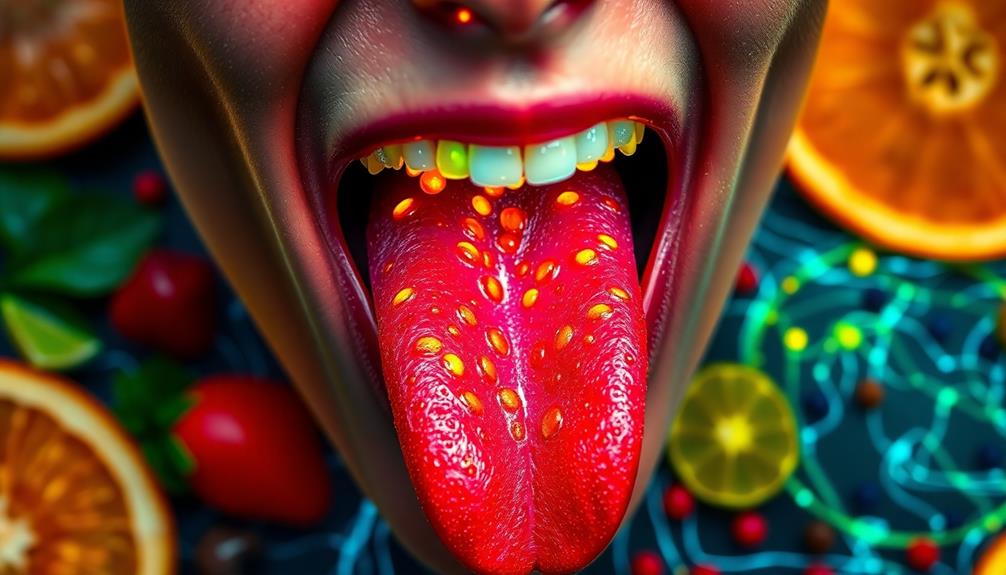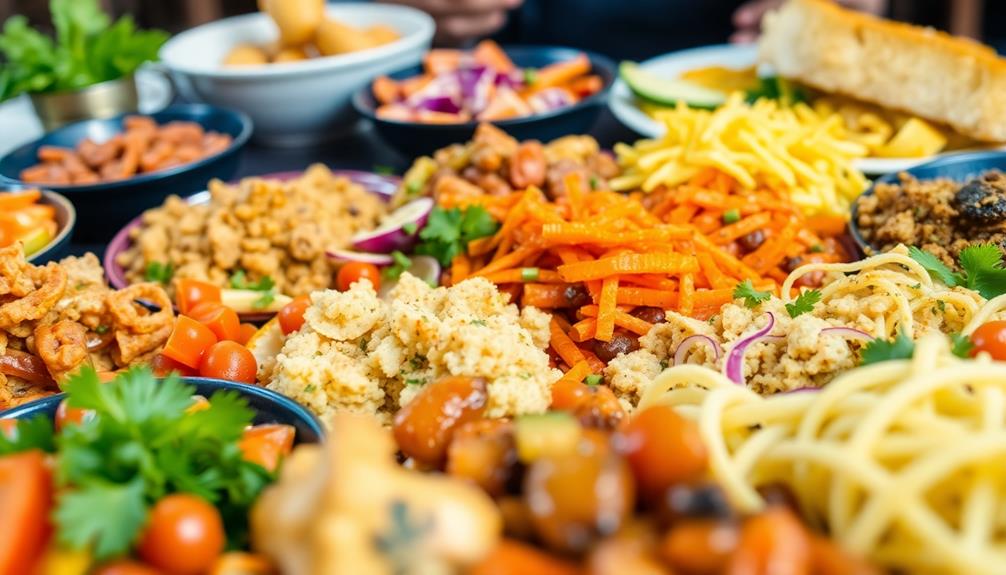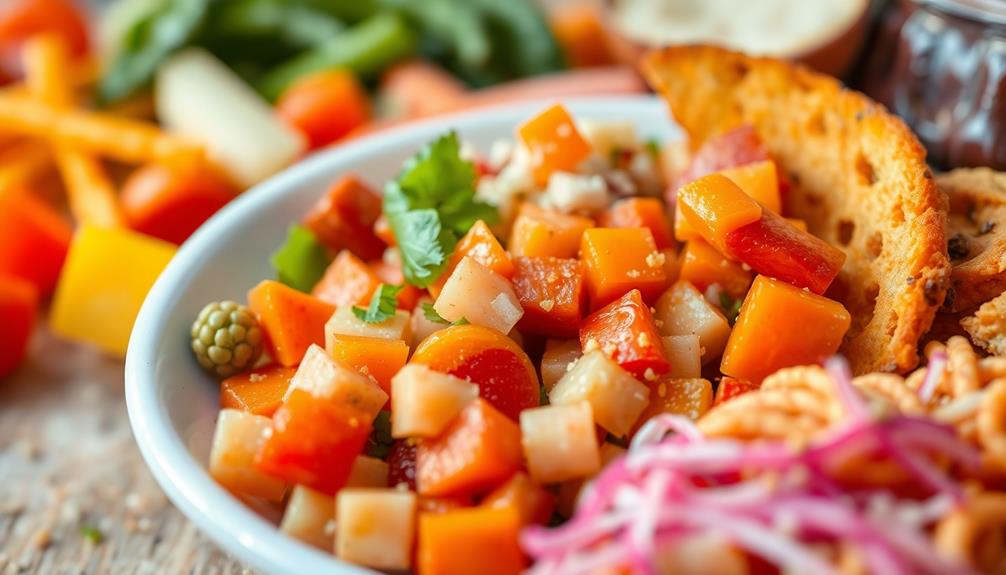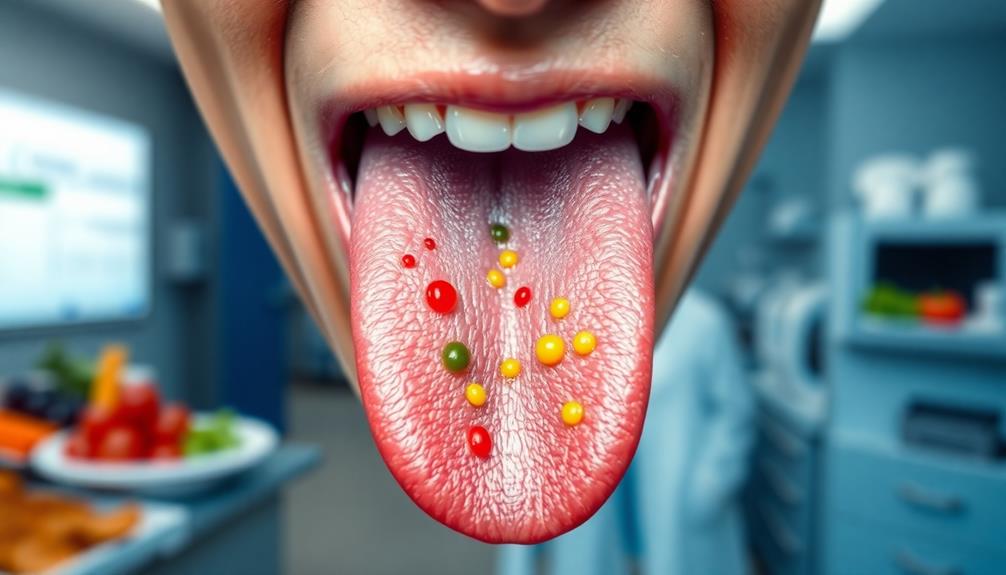The neuroscience of taste bud fatigue shows how quickly sampling similar flavors can dull your ability to distinguish tastes. When you overstimulate your taste buds, the complex signals sent from your taste receptor cells get overwhelmed, leading to a decline in flavor perception. This fatigue can reduce your enjoyment of food and make you prefer simpler flavors. Taking breaks and using palate cleansers, like water or plain crackers, can help reset your taste buds and enhance your overall experience. If you're curious about techniques to manage this sensation, there's much more to explore.
Key Takeaways
- Taste bud fatigue occurs due to overstimulation from rapid exposure to similar flavors, impairing flavor distinction and enjoyment.
- The brain integrates gustatory signals with olfactory cues, and fatigue can complicate this integration, leading to diminished taste perception.
- Continuous exposure to similar tastes increases cognitive load, making complex flavors harder to discern and favoring simpler flavor preferences.
- Palate cleansers and breaks during tasting sessions are essential for resetting taste perception and enhancing flavor recognition.
- Research into the neurophysiological mechanisms of palate fatigue could reveal insights into individual differences in taste sensitivity and preferences.
Understanding Taste Bud Fatigue

Understanding taste bud fatigue is essential for anyone who regularly engages in tasting activities, whether you're a coffee connoisseur or a wine enthusiast.
Taste bud fatigue, or palate fatigue, happens when you sample multiple similar flavors in quick succession, making it harder to distinguish between them. This occurs because your taste buds become overworked, and your brain experiences cognitive fatigue from processing repetitive sensory information. For example, tasting dishes like Red-Braised Pork Belly and Sichuan Cold Noodles in rapid succession may lead to this phenomenon due to their rich and complex flavors.
You'll often notice this phenomenon during professional coffee cupping sessions, where tasters may need to pause for minutes to hours due to sensory overload.
To combat this, taking breaks and using palate cleansers like water or plain crackers can help reset your taste buds and refresh your palate.
If you want to build endurance against palate fatigue, consider using High Volume Taste Training (HVTT). This technique is employed by experienced tasters to enhance resilience over time.
By understanding and addressing taste bud fatigue, you can improve your taste perception, ensuring that each tasting experience remains enjoyable and insightful.
Mechanisms Behind Taste Perception

Taste perception relies on a complex interaction between taste buds and the brain. Your taste buds, located on your tongue, house taste receptor cells (TRCs) that detect various taste modalities. These receptors utilize ion channels for salty and sour tastes, while sweet, bitter, and umami activate G protein-coupled receptors, triggering a cascade of signals.
For instance, the flavors found in traditional Brazilian dishes, such as Caldeirada, exemplify how diverse ingredients can stimulate multiple taste receptors at once.
- Taste buds transform chemical stimuli into electrical impulses.
- The chorda tympani nerve carries signals from the anterior tongue.
- The glossopharyngeal and vagus nerves relay information from the posterior tongue.
- The brain integrates gustatory signals with olfactory cues for flavor perception.
As the TRCs send taste signals through these nerves, your brain processes them, blending taste with smell to create a rich flavor experience.
This intricate system allows you to enjoy a myriad of flavors, but it's also sensitive to overload. When your taste buds are overstimulated by similar flavors, they can lead to palate fatigue, impairing your ability to distinguish between tastes.
Understanding these mechanisms helps you appreciate the delicate balance between taste and perception, enhancing your overall dining experience.
Factors Contributing to Fatigue

When you taste too many similar flavors in a row, your taste buds can get overstimulated, leading to fatigue.
This repetitive sensory input not only tires your palate but also increases the cognitive load on your brain, making it harder to distinguish between flavors.
For instance, indulging in a variety of classic American comfort foods like loaded baked potatoes or onion rings can create a sensory overload.
Let's explore how these factors come together to impact your tasting experience.
Overstimulation of Taste Buds
Overstimulation of taste buds can lead to palate fatigue, a phenomenon that challenges even the most seasoned tasters. When you consume multiple similar flavors in quick succession, your sensory system can become overwhelmed, diminishing your ability to discern distinct tastes. For example, indulging in rich dishes like Mushroom Masala and Chicken Chettinad back-to-back may intensify this effect.
This fatigue isn't just about losing enjoyment; it can also be linked to taste disorders, where your brain struggles to interpret familiar flavors accurately.
Consider these factors contributing to overstimulation:
- Devouring rich, complex dishes back-to-back
- Skipping breaks between tastings, leaving no room for recovery
- Engaging in marathon tasting sessions that push your limits
- Ignoring your body's signals for rest and palate cleansing
Professional tasters, like Q graders and chefs, frequently encounter this challenge. They experience sensory overload during extensive tastings, leading to mixed interpretations of flavors.
The brain's processing limitations play a significant role, as repeated exposure can blur the lines between taste sensations. By regularly practicing palate conditioning, you can enhance your resilience against fatigue, allowing you to maintain sensitivity to flavors even after prolonged exposure.
Repetitive Sensory Input
Repeated exposure to similar flavors can quickly lead to palate fatigue, greatly impacting your ability to appreciate the nuances of taste. When your brain gets overwhelmed by continuous sensory input, it struggles to identify distinct taste notes. This overload can sideline even experienced tasters for minutes or hours, as their sensory pathways become overworked.
Here's a quick look at how palate fatigue develops:
| Factors Contributing to Palate Fatigue | Effects on Taste Perception |
|---|---|
| Repetitive sensory exposure | Diminished ability to identify flavors |
| Rapid succession of identical tastes | Confusion among taste receptors |
| Tasting multiple products in a row | Overwhelmed gustatory system |
| Lack of breaks during tasting | Increased fatigue over time |
| Absence of palate cleansers | Longer recovery time for taste buds |
To mitigate palate fatigue, it's essential to take regular breaks and utilize palate cleansers. These techniques help rejuvenate your taste perception and allow for a more enjoyable tasting experience. Remember, taking care of your palate will enhance your ability to savor the complex world of flavors.
Cognitive Load Influence
Cognitive load considerably impacts your experience of taste, especially when trying to discern complex flavors. When your brain is overwhelmed by mental effort, your ability to identify and enjoy intricate flavors diminishes. High cognitive load can lead to palate fatigue, making those rich, layered tastes feel muddled and indistinct.
For instance, enjoying a grilled peach and burrata salad requires a fine-tuned palate to appreciate the interplay of sweetness and creaminess.
Imagine this scenario:
- A symphony of spices dancing on your tongue
- The vibrant notes of citrus mingling with earthy undertones
- A rich chocolate dessert revealing hidden hints of coffee
- The delicate balance of sweetness and acidity in a fine wine
As cognitive demands increase, you might find yourself gravitating toward simpler flavors, which require less mental processing. Studies show that repeated exposure to similar tastes further exacerbates cognitive load, reducing your flavor recognition.
Fortunately, effective palate training can help you overcome these challenges. By conditioning your taste buds, you can enhance your ability to enjoy and identify complex flavors, even when feeling mentally fatigued.
Embrace the journey of refining your palate, and you'll find that even under cognitive load, the world of taste can be a delightful experience.
Impact on Eating Behavior

The impact of taste bud fatigue on eating behavior can be profound, often steering your food choices toward simpler flavors. When your palate becomes fatigued, you might find it harder to appreciate complex flavors, leading to a preference for foods that are more straightforward.
For example, after enjoying rich and nuanced dishes like Hiyashi Chuka (Cold Ramen), the allure of simpler snacks such as Dorayaki may become more appealing. This shift in taste preferences can make meals less enjoyable, pushing you to seek comfort in familiar, less intricate foods.
Cognitive depletion plays a role here; repeated exposure to similar tastes can disrupt your ability to identify and savor flavors. As enjoyment wanes, you might gravitate toward simpler options, risking a decrease in dietary quality.
In this state, you could end up overeating these basic-flavored foods, hoping to achieve satisfaction that's elusive with complex dishes.
Moreover, experiencing palate fatigue can make you less adventurous in your culinary explorations. Instead of trying new or diverse flavor profiles, you may stick to what you know, missing out on exciting taste experiences.
Recognizing this pattern can help you make more mindful choices, encouraging a broader range of flavors and ultimately enhancing your culinary enjoyment.
Sensory Overload: Cross-Modal Effects

Sensory overload can transform a delightful tasting experience into a confusing jumble of flavors. When you're bombarded with similar stimuli, your ability to distinguish subtle differences diminishes considerably. This phenomenon is particularly evident during tastings, where you may struggle to appreciate the complexity of various tastes and smells.
For instance, trying multiple desserts like Kue Putu and Dadar Gulung in quick succession can lead to palate fatigue, as the sweet and rich flavors may blend together in your mouth.
Imagine the impact of:
- A series of fruity wines with overlapping notes
- A flight of aromatic cheeses, each blending into the next
- A lineup of perfumes that saturate your senses
- A buffet of spices that overwhelm your palate
As you engage with multiple flavors or fragrances in quick succession, you might experience palate fatigue, making it hard to savor individual notes. Your sense of smell plays an essential role in this, as it's deeply intertwined with taste.
After testing several similar products, nasal palate fatigue can set in, dulling your ability to detect distinctive qualities. Furthermore, if you've been mentally drained before a tasting, cognitive depletion can further exacerbate sensory overload, leading you to prefer simpler flavors.
Recognizing these effects can help you navigate tasting experiences more effectively.
Techniques for Prevention

To prevent taste bud fatigue, you should incorporate breaks during your tasting sessions to help reset your palate.
Enjoying diverse flavors, such as a revitalizing cranberry punch or a comforting turkey soup, can also help keep your taste buds engaged.
Using palate cleansers, like water or neutral foods, can also enhance your ability to distinguish different flavors.
Additionally, practicing endurance training can improve your palate's resilience, allowing you to enjoy longer tastings without losing flavor perception.
Breaks Between Tastings
Breaks between tastings are essential for keeping your taste buds sharp and your palate engaged. When you take a moment to pause, you allow your taste buds to recover and clear your mental cache, which helps reduce palate fatigue.
For instance, enjoying a dish like Agnolotti between tastings can provide a delightful contrast in flavors, enhancing your overall tasting experience. Recommended breaks can range from a few minutes to an hour, depending on how intense your tasting session is. This practice boosts your overall sensory performance and keeps your taste experience enjoyable.
Consider these techniques during your breaks:
- Sip on a glass of cool, invigorating water
- Nibble on a piece of plain bread or cracker
- Enjoy a slice of cucumber or apple to reset flavors
- Take deep breaths to clear your senses
Incorporating High Volume Taste Training (HVTT) can also be beneficial. By gradually increasing your exposure to complex flavors with strategic breaks, you can build palate endurance.
Experienced tasters often schedule their sessions with built-in breaks to guarantee they maintain accuracy and enjoyment in flavor assessment. So, don't underestimate the power of a well-timed pause; it can greatly enhance your tasting experience and keep your taste buds lively.
Use Palate Cleansers
Between tastings, using palate cleansers can make a notable difference in your overall experience. These simple yet effective tools help reset your taste buds, allowing you to differentiate flavors more clearly.
For instance, while hosting a Halloween gathering, serving dishes like Graveyard Taco Dip can be enhanced by incorporating palate cleansers to guarantee guests fully appreciate each unique flavor. Common palate cleansers include water, plain bread, or crackers, which neutralize lingering tastes and combat palate fatigue.
Professional tasters, like Q graders and chefs, often rely on palate cleansers to maintain their tasting accuracy. Incorporating a brief pause between tastings and using a palate cleanser can considerably reduce sensory overload. This technique enhances your ability to appreciate complex flavors without being overwhelmed.
Citrus fruits, such as lemon or lime, serve as excellent palate cleansers due to their acidity. They refresh your palate and stimulate your taste receptors, making them a favorite among those in the culinary world.
Endurance Training Practices
Incorporating endurance training practices can greatly enhance your tasting skills and prevent palate fatigue. By systematically exposing yourself to a variety of flavors, you can build taste bud endurance over time.
Here are some effective techniques to evaluate:
- High Volume Taste Training (HVTT): Gradually introduce a broad spectrum of flavors to develop resilience.
- Regular Tasting Sessions: Schedule your tastings with intentional breaks to clear your mental cache, ensuring you can distinguish flavors effectively.
- Mindfulness Techniques: Engage in focused tasting, which helps mitigate cognitive depletion and enhances your flavor recognition.
- Palate Cleansers: Use water or neutral foods between tastings to refresh your palate and avoid flavor blending.
These practices not only strengthen your ability to identify and describe flavors, but they also keep your tasting sessions enjoyable.
Professional Practices in Tasting

Professional tasters, like chefs and Q graders, understand the importance of maintaining a sharp palate during extensive tastings. To combat palate fatigue, they engage in specific practices that enhance their tasting abilities and endurance.
| Practice | Description |
|---|---|
| Conditioning | Regular training to build palate resilience |
| High Volume Taste Training (HVTT) | A method to discern subtle flavor notes over longer sessions |
| Use of Palate Cleansers | Consuming water or neutral foods between tastings to reset taste buds |
| Strategic Breaks | Incorporating breaks to prevent sensory overload |
These professionals often employ High Volume Taste Training (HVTT) to sharpen their skills, ensuring they can detect even the faintest flavors. They also rely on palate cleansers, which help reset taste buds and maintain sensitivity. Aware of palate fatigue, experienced tasters strategically incorporate breaks into their sessions, allowing their senses to recover and stay attuned to the nuances of each flavor. By mastering these techniques, you can considerably reduce the impact of palate fatigue, enabling you to enjoy longer tasting experiences without compromising accuracy or enjoyment.
Clinical Implications of Taste Disorders

Taste disorders can have a profound impact on your nutritional intake and overall health. When your sense of taste is compromised, it can lead to significant issues like weight loss and cachexia, particularly in individuals with chronic illnesses or cancer. About 10% of patients experience taste problems, often linked to olfactory impairment, making it essential to evaluate both senses during clinical assessments.
Reflect on the following implications of taste disorders:
- A diminished ability to enjoy food can lead to decreased appetite.
- Nutritional deficiencies, especially in zinc and vitamin B-12, may worsen taste abnormalities.
- Common medications, like antibiotics and antihypertensives, can induce dysgeusia, necessitating thorough medication reviews.
- Extensive evaluations, including blood tests and consultations with specialists, are necessary for identifying underlying causes.
Understanding and addressing taste disorders is critical for maintaining adequate nutrition and overall health.
Future Research Directions

Understanding taste disorders opens up a pathway to explore various aspects of taste bud fatigue and its implications. Future research should zero in on the neurophysiological mechanisms behind palate fatigue, helping you grasp how sensory overload affects taste perception and enjoyment. By diving into these mechanisms, you can uncover why certain flavors become less enjoyable over time.
Investigating different palate cleansers could offer practical solutions for professionals in the food and beverage industries. You might find that certain cleansers effectively mitigate palate fatigue, enhancing overall tasting experiences.
Additionally, exploring the link between cognitive depletion and palate fatigue could reveal whether low cognitive resources worsen sensory fatigue during tastings.
It's also essential to examine individual differences, such as genetics and flavor exposure, to understand why some people experience palate fatigue more intensely than others.
Finally, consider how environmental factors like noise and lighting affect taste bud fatigue. Optimizing tasting environments could lead to better flavor discernment, ultimately enriching your tasting experiences.
Frequently Asked Questions
How Does Taste Fatigue Occur?
Taste fatigue occurs when you repeatedly expose your taste buds to similar flavors, causing them to become overstimulated and less responsive. This makes it harder for you to distinguish between different tastes over time.
What Is the Neuroscience of Taste Perception?
Taste perception involves your taste buds converting chemical signals into electrical impulses, sending them to your brain. Different receptors detect various tastes, while interactions with your olfactory system shape your overall flavor experience and enjoyment.
How Does the Brain Affect Taste Buds?
Imagine your brain as a maestro, conducting a symphony of flavors. It interprets signals from your taste buds, blending sensory inputs into a harmonious experience, where attention and memory guide the melody of taste.
How to Avoid Taste Fatigue?
To avoid taste fatigue, take breaks between tastings, use palate cleansers like water or crackers, and practice with diverse flavors regularly. Engaging in High Volume Taste Training can also strengthen your palate's endurance over time.
Conclusion
In understanding taste bud fatigue, you're not just scratching the surface; you're diving deep into how our senses interact and affect what we eat. By recognizing the factors that contribute to this phenomenon, you can make smarter choices for your palate. Remember, prevention is key to keeping your taste experience vibrant and enjoyable. So, don't let your taste buds go stale—keep them engaged and savor every bite!










